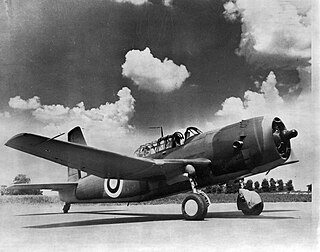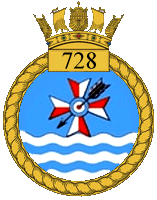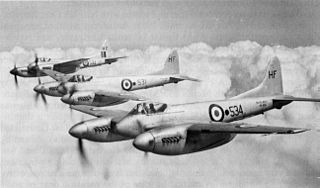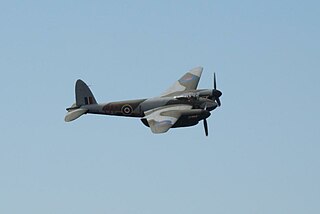
711 Naval Air Squadron was a Naval Air Squadron of the Royal Navy's Fleet Air Arm which disbanded in December 1945. It was first formed from 447 (Catapult) Flight in 1936 and operated out of the Island of Malta, providing flights for the Royal Navy’s 1st Cruiser Squadron. By the beginning of World War II it had become a Squadron and was based in Egypt, but disbanded in 1940 when the Fleet Air Arm centralised the operations of the 700 series "Catapult" flights attached to catapult units. It reformed in September 1944 to provide torpedo bomber reconnaissance (TBR) training. Based at HMS Jackdaw in Fife, Scotland, it was operational for just over one year before it was absorbed by 785 Naval Air Squadron.

721 Naval Air Squadron was a Naval Air Squadron of the Royal Navy's Fleet Air Arm (FAA). 721 Naval Air Squadron formed at HMS Gadwall, RNAS Belfast, Northern Ireland, at the beginning of March 1945, as a Fleet Requirements Unit for the British Pacific Fleet. Initially equipped with Vultee Vengeance target tugs, it arrived at HMS Nabaron, RNAS Ponam, Admiralty Islands in May 1945, and commenced operations towing targets. The squadron moved to HMS Nabsford, RNAMY Archerfield, Brisbane, Australia, during October and then relocated to Hong Kong at the beginning of 1946, moving to HMS Nabcatcher, RNAS Kai Tak, where it eventually disbanded at the end of 1947.

728 Naval Air Squadron was a Naval Air Squadron of the Royal Navy's Fleet Air Arm (FAA). It was formed at the beginning of May in 1943, as a Fleet Requirements Unit, at RN Air Section Gibraltar. It provided detachments at RN Air Section Tafaraoui, in Algeria and later at RAF Oujda in Morocco. Moving to HMS Grebe, RNAS Dekheila, in Egypt, during June, it then merged into 775 Naval Air Squadron during July. It reformed in August, again as a Fleet Requirements Unit, at HMS Grebe, moving immediately to RN Air Section Takali, Malta. It provided target towing both for the Royal Navy's Mediterranean Fleet and the British Army, before later providing a detachment to tow targets for the United States Navy at Naples, Italy. The squadron remained on Malta, alternating between the airbases at Ta Kali, Luqa and Hal Far, until disbanding at the latter, in May 1967.

733 Naval Air Squadron was a Naval Air Squadron of the Royal Navy's Fleet Air Arm. It was active between January 1944 and December 1947, entirely in Ceylon, as a Fleet Requirements Unit, based mainly at R.N. Air Section China Bay, which became HMS Bambara, RNAS Trincomalee, China Bay, Ceylon. The squadron initially formed at R.N. Air Section Minneriya, at RAF Minnerya, Ceylon, two weeks after an advance party arrived there, remaining for three months after formation before relocating.

734 Naval Air Squadron was a Naval Air Squadron of the Royal Navy's Fleet Air Arm (FAA). It was active between February 1944 and February 1946, formed as a naval Engine Handling Unit and operated solely with Armstrong Whitworth Whitley medium bomber aircraft. It formed at and initially operated out of HMS Kestrel, RNAS Worthy Down, and then subsequently relocated to HMS Godwit, RNAS Hinstock and the satellite RNAS Peplow, where it eventually disbanded.

739 Naval Air Squadron was a Naval Air Squadron of the Royal Navy's Fleet Air Arm, which disbanded during 1950. It was formed as the Blind Approach Development Unit for the Fleet Air Arm, operating with Fairey Fulmar and Fairey Swordfish aircraft, at RNAS Lee-on-Solent, in 1942. Just under one year later the squadron moved to RNAS Worthy Down, in late 1943 and continued in the role. Roughly one year later the squadron moved again, relocating to RNAS Donibristle in late 1944, disbanding in 1945. It reformed in 1947 and was based at RNAS Culham, with a new role, as the Fleet Air Arm Photographic Trials and Development Unit.

759 Naval Air Squadron was a Naval Air Squadron of the Royal Navy's Fleet Air Arm. It was created on November 1, 1939, and was disbanded on December 24, 1969. It was initially intended as a Telegraphist Air Gunner Training Squadron but became a Fighter School and Pool Squadron in 1939, at RNAS Eastleigh. It operated out of RNAS Yeovilton from 1940 to 1946, as part of the Naval Air Fighter School. In 1943 a detachment operated out of RNAS Angle, working with 794 NAS and known as the Naval Air Firing Unit. It was again the Naval Air Fighter School upon reformation in 1951 and disbandment in 1954, firstly at RNAS Culdrose and then moving to RNAS Lossiemouth, in 1953. The squadron reformed again, this time at RNAS Brawdy in 1963, as the Naval Advanced Flying Training School, before finally disbanding in 1969.

762 Naval Air Squadron was a Naval Air Squadron of the Royal Navy's Fleet Air Arm (FAA). It formed at HMS Heron, RNAS Yeovilton, in March 1942 as an Advanced Flying Training School. Almost immediately the squadron relocated to HMS Vulture, RNAS St Merryn, but before the end of the year, it was back at HMS Heron. The squadron disbanded nine months later. It reformed in 1944 at HMS Daedalus, RNAS Lee-on-Solent, as a Twin Engine Conversion Unit, but immediately moved to HMS Goldcrest, RNAS Dale, where it operated a variety of multi engined aircraft. At the end of 1945 the squadron moved to HMS Sparrowhawk, RNAS Halesworth and HMS Peregrine, RNAS Ford in quick succession. Now known as the Heavy Twin Conversion Unit it spent nearly two and a half years at HMS Peregrine, before relocating to HMS Seahawk, RNAS Culdrose, where it eventually disbanded at the end of 1949.

769 Naval Air Squadron was a Naval Air Squadron of the Royal Navy's Fleet Air Arm. It last disbanded and merged with 717 Naval Air Squadron after the Second World War. 769 Naval Air Squadron Formed at HMS Merlin, RNAS Donibristle, during May 1939, by renumbering 801 Naval Air Squadron. Its role was a fighter Deck Landing Training Squadron, using HMS Furious for advanced training, before disbanding in the December. It reformed in November 1941, as a unit within the Deck Landing Training School at HMS Condor, RNAS Arbroath, and in November 1943, it moved to HMS Peewit, RNAS East Haven. Its role changed to Torpedo Bomber Reconnaissance Training in 1944, before moving to HMS Merganser, RNAS Rattray, in July 1945.

770 Naval Air Squadron was a Naval Air Squadron of the Royal Navy's Fleet Air Arm. It last disbanded at HMS Nighthawk, RNAS Drem in October 1945. 770 Naval Air Squadron initially formed as a Deck Landing Training Squadron at HMS Daedalus, RNAS Lee-on-Solent, in November 1939. Embarked in HMS Argus, and operated from the aircraft carrier and Hyeres la Palyvestre in the south of France, until it disbanded in May 1940. It reformed at HMS Merlin, RNAS Donibristle, on New Year’s Day 1941, as a Fleet Requirements Unit out of 771 Naval Air Squadron’s 'X' Flight. It moved to HMS Jackdaw, RNAS Crail, in June 1941, then two and half years later it moved to HMS Jackdaw II, RNAS Dunino in January 1944, before finally moving to HMS Nighthawk in July.

772 Naval Air Squadron was a Naval Air Squadron of the Royal Navy's Fleet Air Arm which last disbanded during September 1995. 772 Naval Air Squadron formed as a Fleet Requirements Unit out of 'Y' Flight from 771 Naval Air Squadron at RNAS Lee-on-Solent in September 1939. While the headquarters remained there, floatplanes were operated out of RNAS Portland, however, mid 1940 saw the whole squadron move north to RNAS Campbeltown and roughly twelve months afterwards the short distance to RNAS Machrihanish. The unit moved to RNAS Ayr in July 1944 and became the Fleet Requirements Unit School. In January 1946 the squadron moved to RNAS Burscough in Lancashire, before moving to RNAS Anthorn in Cumberland, in May. It became the Northern Fleet Requirements Unit upon moving to RNAS Arbroath, in June 1947, but disbanded into 771 Naval Air Squadron in October. 772 Naval Air Squadron reformed as a Helicopter Support Squadron at RNAS Portland in September 1974. In September 1977 the squadron took over responsibility for a number of Ships' Flights of Royal Fleet Auxiliary ships. The squadron was used to reform 848 Naval Air Squadron for the Falklands Task Force in 1982, with the Ships' Flights absorbed into 847 Naval Air Squadron. In August 1982 it took on the Anti-Submarine Warfare Flight from 737 Naval Air Squadron and between 1983 - 1985 a Search and Rescue Flight operated out of RNAS Lee-on-Solent.

773 Naval Air Squadron was a Naval Air Squadron of the Royal Navy's Fleet Air Arm which was last active between September 1950 and March 1951. 773 Naval Air Squadron initially formed during June 1940, as a Fleet Requirements Unit in Bermuda, in support of ships on the North America and West Indies Station. It performed this role four almost four years and eventually disbanded, at Bermuda, in April 1944. The squadron reformed during June 1945 as a Service Trials Unit, at HMS Daedalus, RNAS Lee-on-Solent. Tasked with investigating pilotless aircraft as targets, it was known as the Pilotless Aircraft Unit (PAU). It moved to HMS Goldcrest II, RNAS Brawdy where it disbanded in September 1946. The squadron reformed at the start of 1949 as a Fleet Requirements Unit, out of 771 Naval Air Squadron, lasting around three months and repeated this at the start of 1950 and again at the end of 1950, into 1951.

775 Naval Air Squadron was a Naval Air Squadron of the Royal Navy's Fleet Air Arm which last disbanded in March 1946. 775 Naval Air Squadron formed at HMS Grebe, RNAS Dekheila, during November 1940, as a Fleet Requirements Unit in support of the Mediterranean Fleet, based at Alexandria, Egypt. Between October 1941 and March 1942 the squadron also included the RN Fighter Flight. It absorbed 728 Naval Air Squadron in July 1943 and moved to R.N.Air Section Gibraltar at the start of February 1944. The squadron returned to HMS Grebe, RNAS Dekheila during August 1945.

776 Naval Air Squadron was a Naval Air Squadron of the Royal Navy's Fleet Air Arm which last disbanded at the end of October 1945. 776 Naval Air Squadron formed as a Fleet Requirements Unit at HMS Daedalus, RNAS Lee-on-Solent, at the start of 1941. It operated a detachment at RN Air Section Speke in 1941 and one at RAF Woodvale in 1942, with the squadron wholly moving to Speke in the October. 1943 saw further detachments and these were deployed at RAF Llanbedr, RAF Millom, RAF Usworth and RAF Waltham. In April 1945, the Woodvale detachment was reabsorbed into the squadron when it relocated there, the airbase now operated by the Admiralty and known as HMS Ringtail II. It moved to HMS Ringtail, RNAS, Burscough, at the start of October 1945.

777 Naval Air Squadron was a Naval Air Squadron of the Royal Navy's Fleet Air Arm, which formed as a Fleet Requirements Unit in West Africa during the Second World War. Throughout most of 1943, the squadron was responsible for the air defence of Sierra Leone. It disbanded at HMS Spurwing, RNAS Hastings, Sierra Leone, during December 1944. The squadron reformed in May 1945, from 'B' Flight of 778 Naval Air Squadron, as a Carrier Trials Unit operating aboard HMS Pretoria Castle, and using shore bases at HMS Siskin, RNAS Gosport, and HMS Peregrine, RNAS Ford in England, and HMS Wagtail, RNAS Ayr, in Scotland. 777 Naval Air Squadron number was assigned to the aircraft collection at the Fleet Air Arm Museum in April 2006.

780 Naval Air Squadron was a Naval Air Squadron of the Royal Navy's Fleet Air Arm which last disbanded at HMS Seahawk, RNAS Culdrose in November 1949. 780 Naval Air Squadron formed at HMS Raven, RNAS Eastleigh as a Conversion Course Unit, in October 1939, to train experienced civilian pilots in naval flying. It moved to HMS Daedalus, RNAS Lee-on-Solent, in October 1940, and later, its role had changed to converting pilots to Fairey Barracuda aircraft. It spent a year at RNAS Charlton Horethorne, before returning to HMS Daedalus and disbanded, early 1945. In March 1946, the squadron reformed at HMS Godwit, RNAS Hinstock, as the Naval Advanced Flying School, to give flying instructors' courses, and later provided Instrument Flying Training. In December, the squadron moved to HMS Jackdaw, RNAS Crail, then in March 1947 moved to HMS Merlin, RNAS Donibristle, and in May to HMS Seahawk as the first resident unit.

786 Naval Air Squadron was a Naval Air Squadron of the Royal Navy's Fleet Air Arm which last disbanded in late 1945, absorbed by 785 Naval Air Squadron. 786 NAS formed at HMS Jackdaw, RNAS Crail, in November 1940, as a Torpedo Bomber Reconnaissance squadron. It operated a few different types of torpedo bomber aircraft, initially equipped with Fairey Albacore and shortly afterwards joined by Fairey Swordfish, these aircraft were replaced by Fairey Barracuda at the of 1942.

790 Naval Air Squadron was a Naval Air Squadron of the Royal Navy's Fleet Air Arm which disbanded in November 1949 at RNAS Culdrose. It initially formed during 1941 as an Air Target Towing Unit, at HMS Landrail, RNAS Macrihanish, in Scotland, from elements of two other Fleet Air Arm squadrons, however, this only lasted for three months and the unit was disbanded, absorbed into 772 Naval Air Squadron. It reformed the following year, in July 1942, tasked as a Fighter Direction Training Unit, at RNAS Charlton Horethorne. It provided support for the Fighter Direction School and had short spells at RAF Culmhead and RNAS Zeals, before reloacting to RNAS Dale in Pembrokeshire, next to the new purpose built Air Direction School, HMS Harrier or RNADC Kete, in 1945. The squadron moved to HMS Seahawk in Cornwall during December 1947.

793 Naval Air Squadron was a Naval Air Squadron of the Royal Navy's Fleet Air Arm which disbanded during October 1945. It was formed in October 1939 at RNAS Ford, as an Air Towed Target Unit, as part of No.1 Observer School. From 1940 to disbandment it operated at RNAS Piarco , Trinidad.

797 Naval Air Squadron was a Naval Air Squadron of the Royal Navy's Fleet Air Arm which last disbanded in October 1945 in Ceylon. Its role was a Fleet Requirements Unit which formed at HMS Ukussa, Royal Naval Air Station Katukurunda, in Ceylon, in July 1942. The squadron moved to RNAS Colombo Racecourse in October 1943. It had a Communications Flight which became 742 Naval Air Squadron in December 1943 and the following summer it had an ‘X’ Flight deployed for target towing for a couple of gunnery schools in Bombay, India and which eventually moved to 722 Naval Air Squadron.




















